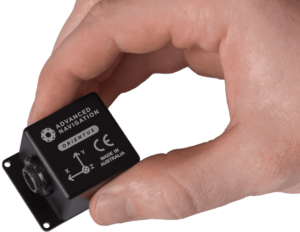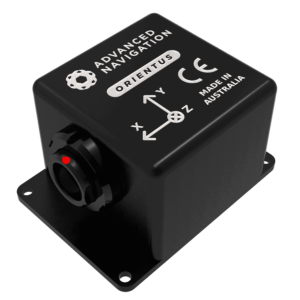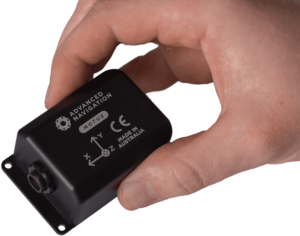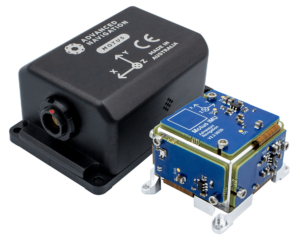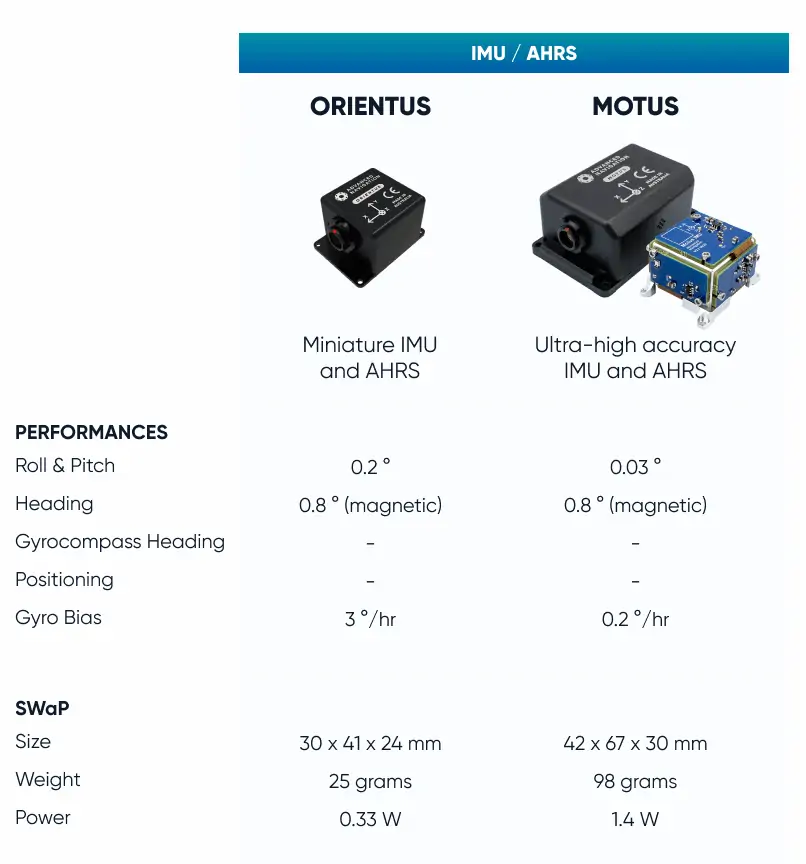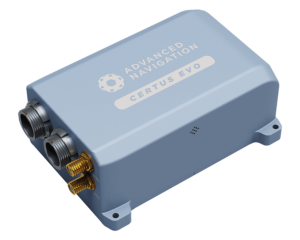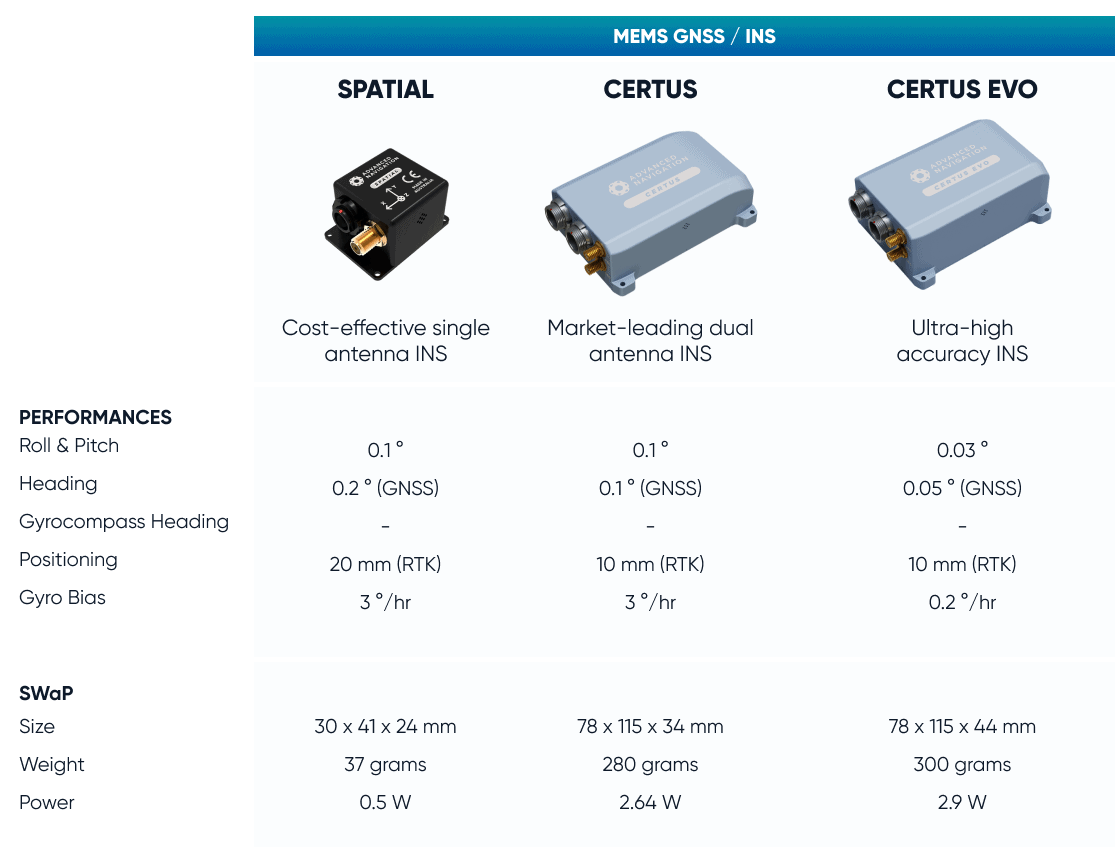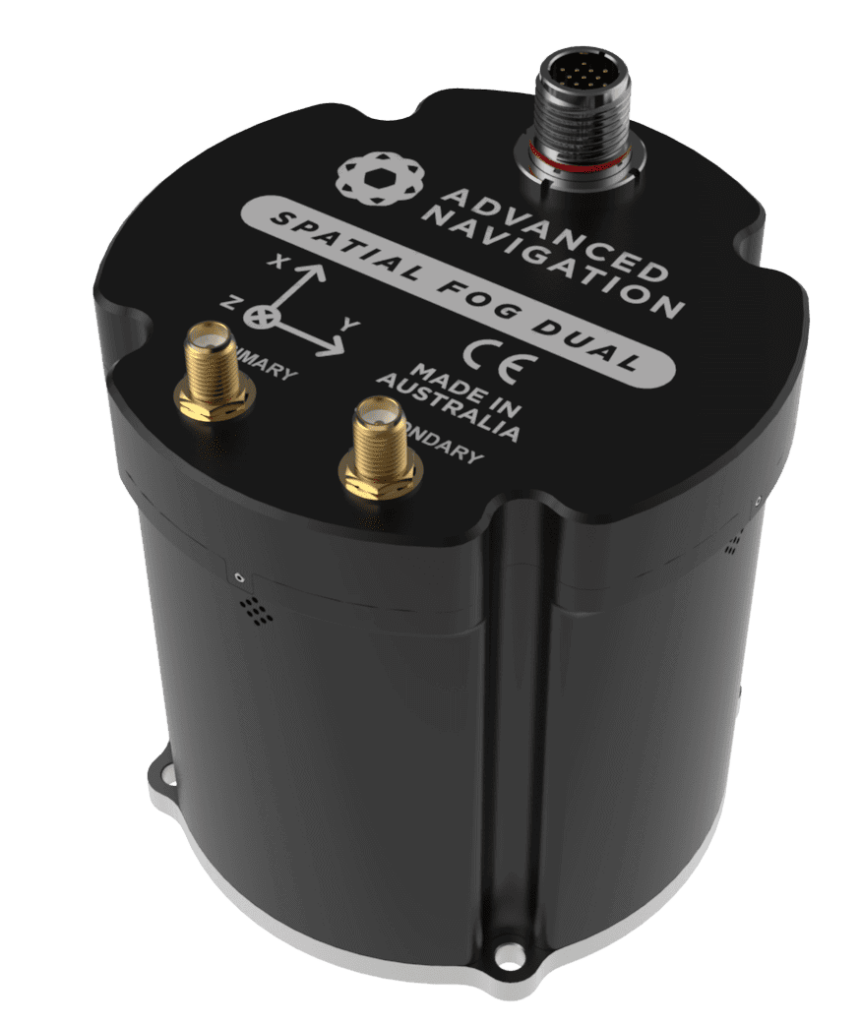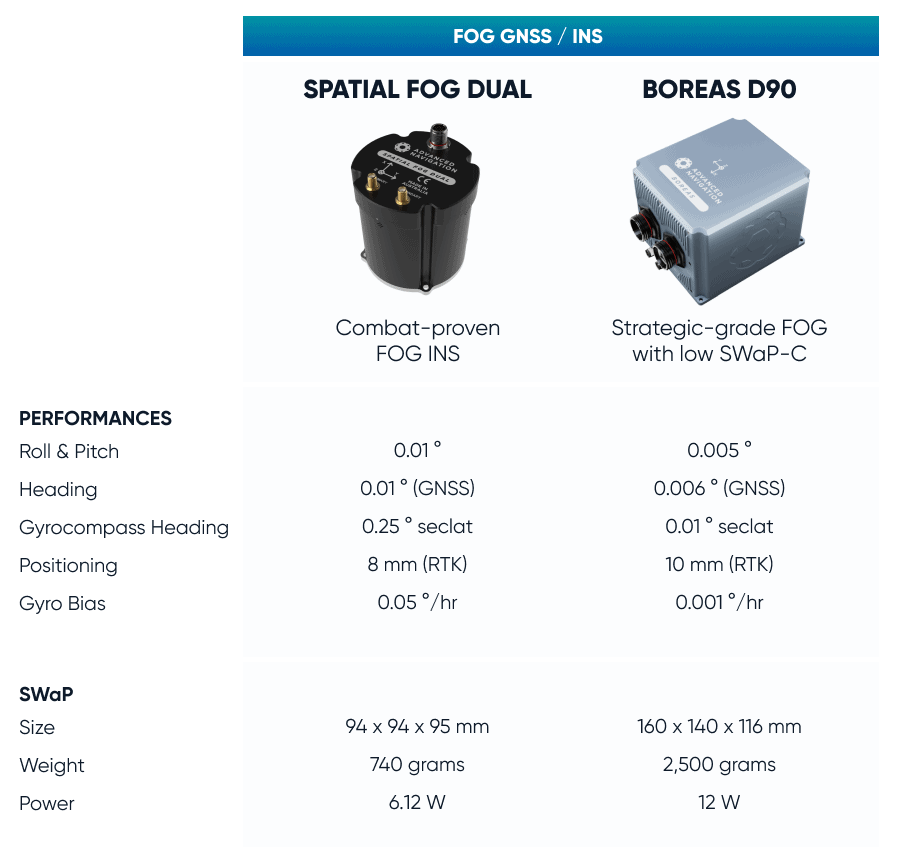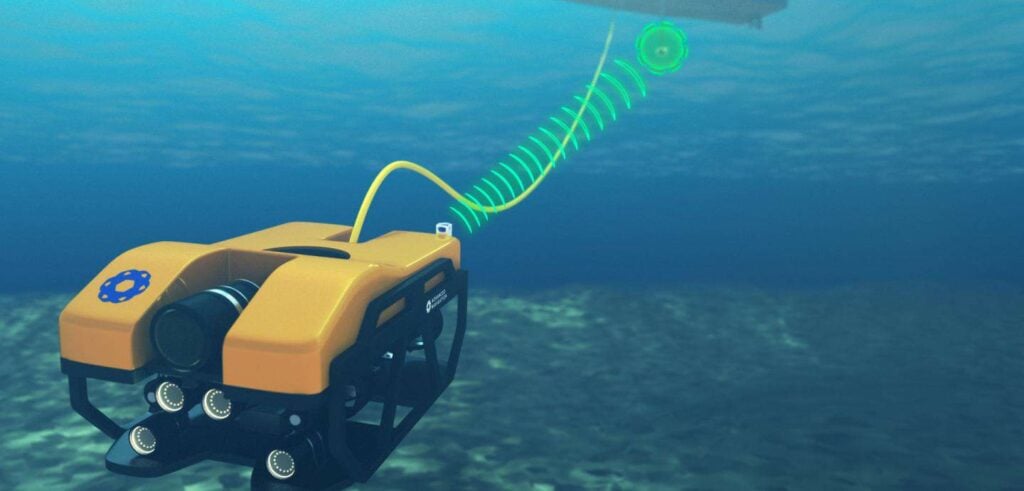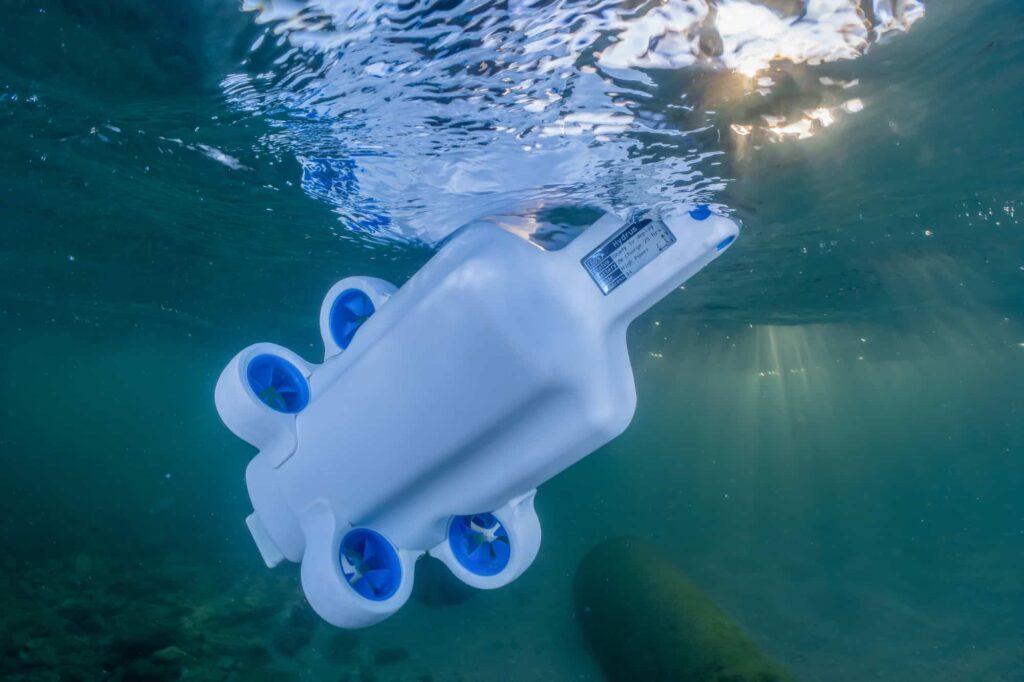Advanced Navigation is a leading manufacturer of high accuracy inertial navigation systems for Commercial and Defense applications. Our MEMS (Micro Electro-Mechanical systems) and FOG (Fiber Optic Gyro) based navigation products are ideal for a wide range of UAV (unmanned aerial vehicle), UGV (unmanned ground vehicle) and AUV (autonomous underwater vehicle) applications.
High-performance and compact IMU & AHRS
Orientus Miniature MEMS AHRS Sensor
Compact, rugged AHRS for stabilization and control
Orientus is a ruggedized miniature orientation sensor and AHRS (Attitude & Heading Reference System) that combines temperature calibrated MEMS accelerometers, gyroscopes and magnetometers using a state-of-the-art fusion algorithm to deliver accurate and reliable orientation in even the most demanding environments.
The minimal size, weight and power requirements make it ideal for unmanned vehicle applications such as platform and camera stabilization, as well as a heading reference source for unmanned surface vehicles.
- Linear Acceleration Compensation
- Magnetic Interference Mitigation
- Low Weight : 25 grams
- Small Size : 30 x 30 x 24 mm
- Low Power : 65 mA @ 5V
Find out more: Orientus Miniature AHRS
Motus Miniature MEMS IMU Sensor
Ultra-high accuracy miniature inertial sensor for UAVs
Motus is a miniature ultra-high accuracy MEMS IMU (inertial measurement unit) that combines ultra-high accuracy accelerometers and gyroscopes with magnetometers to provide inertial performance that exceeds even some FOG IMUs.
With a volume of just over 1 cubic inch and a weight of only 26 grams, Motus is ideal for SWaP-conscious applications, such as geopointing and LiDAR missions with VTOL UAVs.
- Hot Start Time : 2 seconds
- IMU, AHRS and INS options
- 2 versions : OEM or Rugged
Find out more: Motus Miniature MEMS IMU
Certus and Certus Evo GPS-Aided INS & AHRS
Rugged low-SWAP positioning solutions for UAVs and Robotics
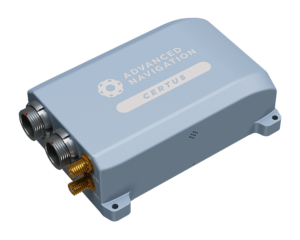 Certus and Certus Evo are rugged low-SWaP, ITAR-free GPS-aided INS and AHRS modules that combine temperature-calibrated accelerometers, gyroscopes, magnetometers and a pressure sensor with a dual antenna RTK GNSS receiver, all coupled with a cutting-edge AI-based sensor fusion algorithm.
Certus and Certus Evo are rugged low-SWaP, ITAR-free GPS-aided INS and AHRS modules that combine temperature-calibrated accelerometers, gyroscopes, magnetometers and a pressure sensor with a dual antenna RTK GNSS receiver, all coupled with a cutting-edge AI-based sensor fusion algorithm.
Certus modules incorporate dual antenna moving baseline RTK, providing highly accurate heading data for both stationary and moving vehicles even in magnetically problematic environments.
Certus and Certus Evo are ideal for UAV and USV surveying, antenna and weapons platforms targeting, and stabilization of robotic systems.
- Dual Antenna Heading
- Free Multi-Constellation RTK
- Ethernet, CAN, RS232, RS422 and GPIO Interfaces
- Internal Data Logging
- OEM or Rugged options
Find out more: Certus and Certus Evo GPS-Aided INS
Spatial Miniature GPS-Aided INS/AHRS
Rugged inertial navigation system for UAVs and Robotics
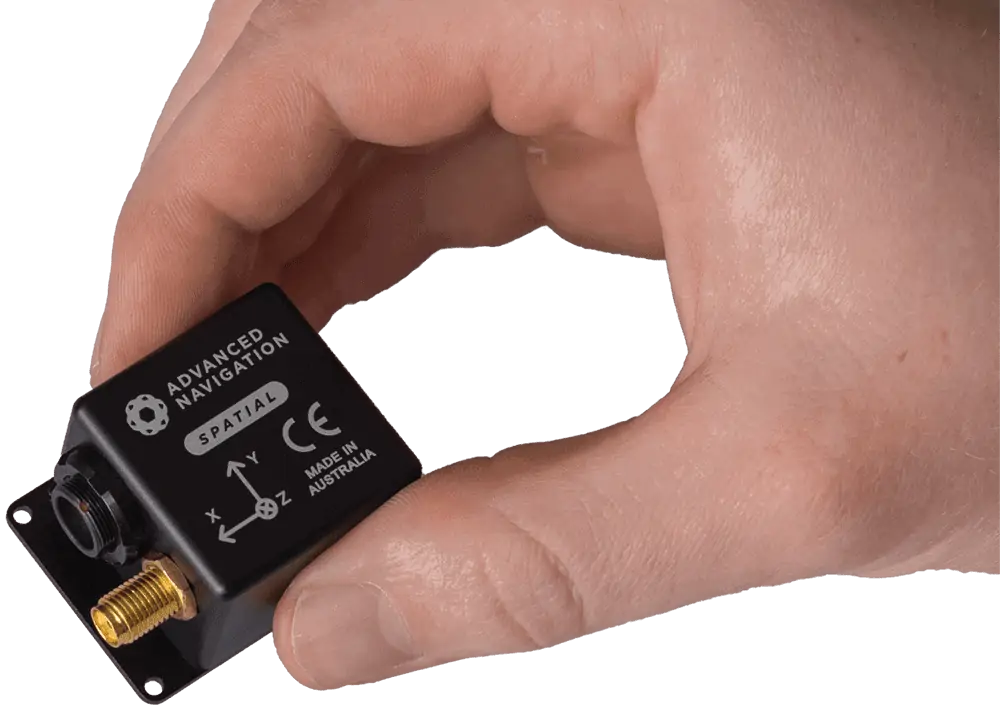 Spatial is a ruggedized miniature GPS-aided INS (inertial navigation system) and AHRS that provides accurate position, velocity, acceleration and orientation outputs. It couples high-performance MEMS inertial sensors and a pressure sensor with an advanced GNSS receiver using an AI-driven fusion algorithm to deliver accurate and reliable navigation and orientation.
Spatial is a ruggedized miniature GPS-aided INS (inertial navigation system) and AHRS that provides accurate position, velocity, acceleration and orientation outputs. It couples high-performance MEMS inertial sensors and a pressure sensor with an advanced GNSS receiver using an AI-driven fusion algorithm to deliver accurate and reliable navigation and orientation.
With low SWaP requirements, Spatial is ideal for UAV surveying and geo-referencing missions, as well as tracking, security and platform stabilization for a wide range of robotic systems.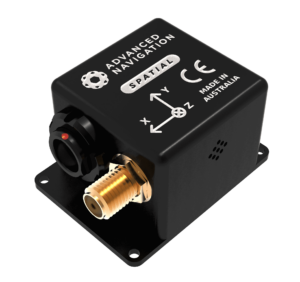
Key Features:
- Multi-Constellation RTK
- Hot Start Time : 500 ms
- Low Weight : 30 grams
- Small Size : 30 x 30 x 24 mm
- Low Power : 65 mA @ 5V
Find out more: Spatial Miniature GPS-Aided INS/AHRS
Spatial FOG Dual GPS-Aided INS/AHRS
Rugged FOG INS with dual antenna heading
The Spatial FOG Dual is a dual-antenna moving baseline RTK variant of the Spatial FOG GPS-aided INS/AHRS. It provides highly accurate heading output while both stationary and moving. The triple frequency Trimble RTK GNSS receiver provides up to 8mm accuracy positioning and supports all of the current and future satellite navigation systems, as well as the Omnistar service for even higher accuracy positioning.
Key Features:
- Dual Antenna Heading
- L1/L2 RTK/PPK
- Hot Start Time : 2 seconds
- Low size, Weight and Power
Find out more: Spatial FOG Dual GPS-Aided INS/AHRS
Boreas D90 Digital FOG INS
Strategic-grade INS with low SWaP-C
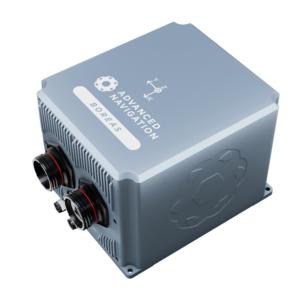 The Boreas D90 is an ultra-high accuracy, strategic-grade INS, offering a 40% reduction in size, weight, power, and cost relative to competing systems. Boreas D90 is the first product to be released that is based on Advanced Navigation’s new DFOG (Digital Fiber Optic Gyroscope) technology, which is the culmination of 25 years of development involving two research institutions.
The Boreas D90 is an ultra-high accuracy, strategic-grade INS, offering a 40% reduction in size, weight, power, and cost relative to competing systems. Boreas D90 is the first product to be released that is based on Advanced Navigation’s new DFOG (Digital Fiber Optic Gyroscope) technology, which is the culmination of 25 years of development involving two research institutions.
The Boreas D90 is targeted at applications requiring always available, ultra-high accuracy, orientation, and navigation including marine, surveying, subsea, aerospace, robotics, and space.
Key Features:
- Dual Antenna Heading
- GPS L1, L2, GLONASS L1, L2, GALILEO E1, E5b, BeiDou B1, B2, RTK/PPK
- Hot Start Time : 2 seconds
- Low size, Weight and Power
Find out more: Boreas D90 Digital FOG INS
Subsonus Underwater Acoustic Positioning System
High accuracy, miniature USBL for AUVs, ROVs
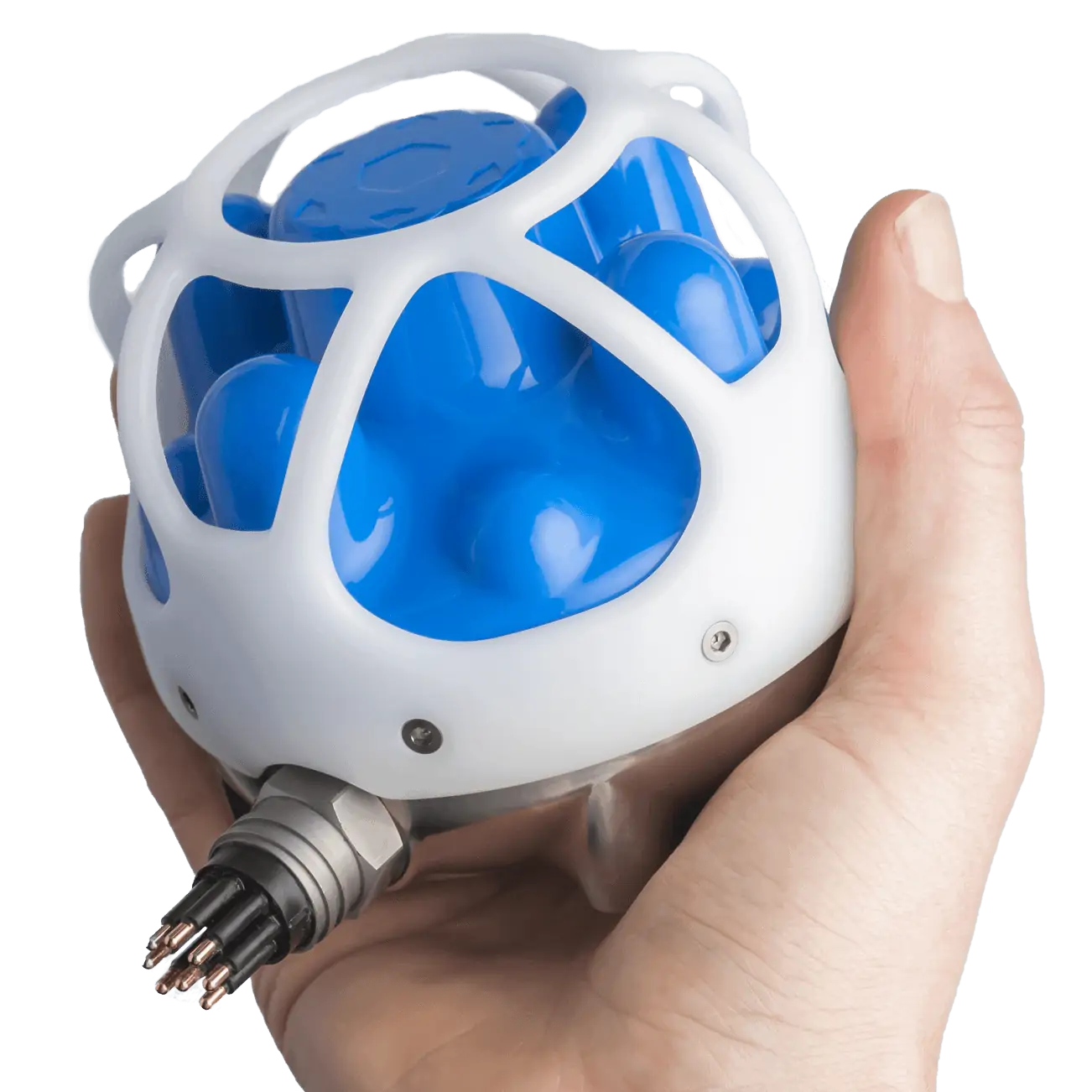 Subsonus is a next-generation USBL underwater acoustic positioning system combining an industry-leading eight channel factory calibrated hydrophone array with an internal tightly coupled INS. Capable of operating at depths of up to 1000 metres, it fuses acoustic position and doppler velocity with factory calibrated inertial sensors and a depth sensor, providing highly accurate position, velocity and heading outputs.
Subsonus is a next-generation USBL underwater acoustic positioning system combining an industry-leading eight channel factory calibrated hydrophone array with an internal tightly coupled INS. Capable of operating at depths of up to 1000 metres, it fuses acoustic position and doppler velocity with factory calibrated inertial sensors and a depth sensor, providing highly accurate position, velocity and heading outputs.
Subsonus is ideal for station keeping, control and subsea surveying applications for both AUVs (autonomous underwater vehicles) and ROVs (remotely operated vehicles).
Key Features:
- Sound Velocity Sensor
- Very Low Size, Weight and Power
- Multipath Rejection
- Acoustic Modem
- Integrated INS
- Speed of Sound Sensor
Find out more: Subsonus Underwater Acoustic Positioning System
Subsonus Tag Acoustic Positioning Transponder
Low cost sensor for sub-sea remote sensing and tracking
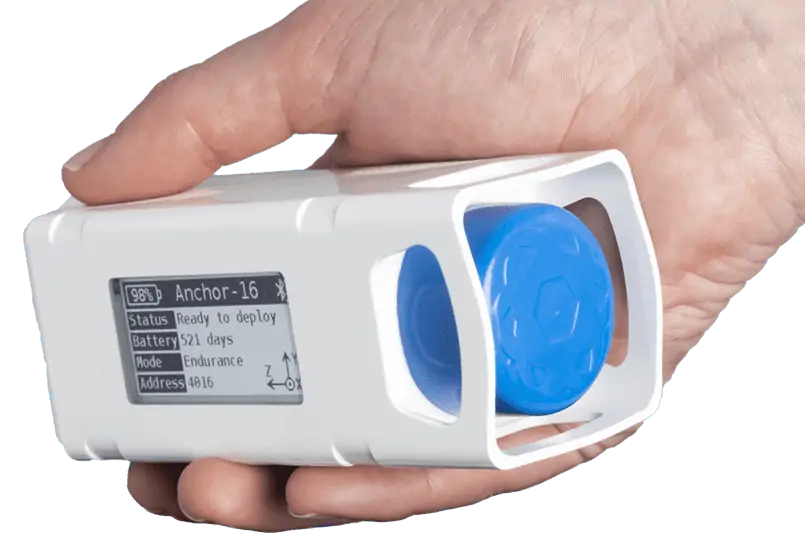 Subsonus Tag is a low cost acoustic positioning transponder designed for use with our Subsonus USBL. The hermetically sealed unit features an integrated battery, wireless charging and a low-power pressure tolerant e-paper display. Up to 65,000 Tags can be tracked by one surface Subsonus unit, and each tag can operate at a range of up to 1000 metres and at a depth of up to 2000 metres for up to 18 months on one charge.
Subsonus Tag is a low cost acoustic positioning transponder designed for use with our Subsonus USBL. The hermetically sealed unit features an integrated battery, wireless charging and a low-power pressure tolerant e-paper display. Up to 65,000 Tags can be tracked by one surface Subsonus unit, and each tag can operate at a range of up to 1000 metres and at a depth of up to 2000 metres for up to 18 months on one charge.
Subsonus Tag is ideal for remote sensing of position, orientation, heading and temperature, as well as tracking of underwater unmanned vehicles such as AUVs and ROVs.
Key Features:
- 18 Months Battery Life
- Very low size, Weight and Power
- No Maintenance
- Cost Effective
- Integrated Display
Find out more: Subsonus Tag Acoustic Positioning Transponder
Post Processing Software
 Kinematica Post Processing Software
Kinematica Post Processing Software
Web-based GNSS/INS post processing software
Kinematica is web-based GNSS/INS post-processing software for raw GNSS and inertial data from any of our GNSS/INS products.
Kinematic GNSS post-processing provides an up to 200 times increase in position accuracy over standard real-time GNSS. The Kinematica software automatically downloads the closest RINEX base station data and outputs position to an accuracy of 8mm.
Kinematica utilises forward and backwards looking in time to fill satellite outages and compensate for errors that would normally affect a real-time solution. It also supports both loosely and tightly coupled GNSS/INS processing, automatically switching between them to provide the best accuracy results under the conditions at that point in time.
Ideal for post processing data acquired from surveying, LiDAR and aerial photography applications.
Find out more: Kinematica Post Processing Software
Micro-AUV
Hydrus Autonomous Underwater Vehicle
Micro-AUV for underwater surveying & inspection
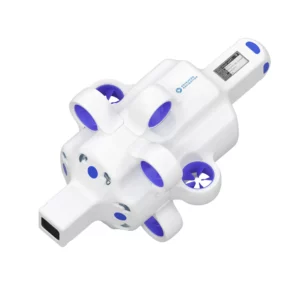 Hydrus is a compact AUV designed to capture high-resolution images and video with precise geo-referenced data, and to simplify underwater surveying and inspection missions.
Hydrus is a compact AUV designed to capture high-resolution images and video with precise geo-referenced data, and to simplify underwater surveying and inspection missions.
The all-in-one autonomous robotic vehicle includes a 4K 60 FPS camera coupled with powerful lighting, as well as tightly coupled USBL, DVL, INS, and acoustic and optical modems. The innovative design includes hubless thrusters that prevent impellers from getting jammed with ropes or seaweed, and is designed to be highly reliable and low maintenance.
Hydrus also features an AI-powered image processing system that dynamically balances camera settings and lighting, and compensates for turbidity even in the most challenging of environments.
Find out more: Hydrus Autonomous Underwater Vehicle



